
TNU Journal of Science and Technology
229(14): 184 - 191
http://jst.tnu.edu.vn 184 Email: jst@tnu.edu.vn
A METHOD TRACKING MOBILE ROBOT INDOOR ENVIRONMENT
USING CEILING CAMERA
USING YOLOv9
*
Luu Trong Hieu
, Nguyen Tan Dung
College of Engineering -
Can Tho University
ARTICLE INFO
ABSTRACT
Received:
11/9/2024
This study presents a method for determining the position of a mobile
robot within an indoor environment using a ceiling-mounted camera
and the YOLOv9 deep learning network. Conventional solutions often
involve attaching a QR code tag to the robot; however, such tags are
usually small, prone to noise, and affected by lighting conditions.
Therefore, we propose the YOLOv9 deep learning network to track the
random movement of the robot. Additionally, the robot's state while
navigating through a maze is represented using optical flow methods.
We also conduct transforming coordinates from the camera coordinate
system to the Cartesian coordinate system to detect the current position
of the mobile robot. The results indicate that the proposed solution can
effectively record the entire trajectory of the robot within the maze. At
a instantenous point, the optical flow method also demonstrates the
robot's state during straight movement, rotation, and proximity to
obstacles. These results provide a foundation for addressing advanced
problems in mobile robotics, such as trajectory planning and tracking in
indoor environments.
Revised:
29/10/2024
Published:
30/10/2024
KEYWORDS
Mobile robot
YOLOv9
Detection and tracking
Casterian coordinate system
Optical flow
GIẢI PHÁP THEO DÕI ROBOT DI ĐỘNG HOẠT ĐỘNG TRONG NHÀ
BẰNG CAMERA TRẦN SỬ DỤNG MẠNG HỌC SÂU YOLOv9
Lưu Trọng Hiếu*, Nguyễn Tấn Dũng
Trường Bách khoa - Trường Đại học Cần Thơ
THÔNG TIN BÀI BÁO
TÓM TẮT
Ngày nhận bài:
11/9/2024
Nghiên cứu này trình bày một giải pháp xác định vị trí của robot di
động trong môi trường trong nhà bằng một máy ảnh trần sử dụng mạng
học sâu YOLOv9. Những giải pháp cổ điển, robot di động được gắn
một thẻ qr-code, tuy nhiên thẻ thường có kích thước nhỏ, dễ bị nhiễu và
bị ảnh hưởng bởi độ sáng. Vì vậy, nhóm nghiên cứu để xuất giải pháp
sử dụng một mạng học sâu YOLOv9 để theo dõi quá trình di chuyển
ngẫu nhiên của robot. Thêm vào đó, trạng thái của robot khi di chuyển
trong mê cung được biểu diễn bằng phương pháp dòng quang học.
Nhóm cũng đề xuất một giải pháp biến đổi hệ tọa độ từ hệ tọa độ máy
ảnh sang hệ tọa độ Descartes để có thể xác định được vị trí hiện tại của
robot di động. Kết quả cho thấy giải pháp đề xuất có thể ghi lại toàn bộ
quỹ đạo di chuyển của robot trong mê cung. Trong thời điểm tức thời,
phương pháp dòng quang học cũng cho thấy được trạng thái của robot
khi chuyển động thẳng, xoay và gần chướng ngại vật. Kết quả này là
tiền đề để giải quyết các toán nâng cao trong robot di động như lập và
theo dõi quỹ đạo trong môi trường trong nhà.
Ngày hoàn thiện:
29/10/2024
Ngày đăng:
30/10/2024
TỪ KHÓA
Robot di động
Mạng học sâu YOLOv9
Phát hiện và theo dõi đối tượng
Hệ tọa độ Casterian
Dòng quang học
DOI: https://doi.org/10.34238/tnu-jst.11101
* Corresponding author. Email: luutronghieu@ctu.edu.vn

TNU Journal of Science and Technology
229(14): 184 - 191
http://jst.tnu.edu.vn 185 Email: jst@tnu.edu.vn
1. Giới thiệu
Robot di động đã được nghiên cứu và ngày càng được ứng dụng nhiều hơn trong các lĩnh vực
thực tế: sản xuất công nghiệp, dịch vụ y tế, nhiệm vụ quân sự, hoạt động nhà ở, thám hiểm hành
tinh, giải trí,… Trong kỹ thuật điều khiển robot di động, vấn đề điều hướng là một trong những
hoạt động quan trọng nhất. Có thể chia thành ba vấn đề cơ bản: lập và theo dõi quỹ đạo, theo dõi
đường đi và ổn định điểm. Trong vấn đề theo dõi đường đi, các nghiên cứu đề cập đến việc trích
xuất, phát hiện, nhận dạng và theo dõi robot di động từ môi trường của nó để có được các thông
số chuyển động như vị trí, quỹ đạo, vận tốc và gia tốc của robot di động.
Có nhiều giải pháp để định vị robot trong điều kiện trong nhà, nổi bật nhất gồm hai giải pháp:
sử dụng hệ cảm biến và sử dụng máy ảnh số. Trong giải pháp sử dụng hệ cảm biến, Banu [1]
trình bày giải pháp định vị robot bằng mạng học sâu sử dụng tín hiệu từ cảm biến laser. Mặc dù
phương pháp cho kết quả định vị tốt, việc tích hợp cảm biến laser lên robot thường không phù
hợp khi có tương tác với con người. Khan và các đồng nghiệp [2] sử dụng một hệ cảm biến gắn
trên robot di động để định vị vị trí trong nhà kín, tuy nhiên sử dụng nhiều thiết bị trong một
không gian lớn có thể gây lãng phí tài nguyên. Bên cạnh đó, Liping [3] cũng đề xuất một giải
pháp định vị robot bằng hệ cảm biến không dây, tuy nhiên giải pháp này không cho biết trạng
thái đang chuyển động của robot trong thời điểm ngẫu nhiên. Các nghiên cứu [4] – [6] đề xuất
giải pháp định vị robot di động dựa trên công nghệ nhận dạng tần số vô tuyến (radio frequency
identification (RFID)). Trong phương pháp này, một số thẻ RFID được gắn trên sàn để cung cấp
thông tin tham chiếu vị trí và chúng được phát hiện và nhận dạng bởi đầu đọc RFID gắn trên
robot. Độ chính xác và độ bền của các phương pháp này phụ thuộc vào khoảng cách giữa các thẻ
và khoảng cách giữa các thẻ và đầu đọc. Để tăng độ chính xác định vị, số lượng thẻ RFID trên
một đơn vị diện tích phải được tăng lên. Do đó, kỹ thuật này có thể không mang lại giải pháp
kinh tế và dễ mở rộng quy mô do số lượng thẻ cần thiết ngày càng tăng và chi phí triển khai liên
quan. Trong giải pháp sử dụng hệ máy ảnh, nghiên cứu [7] đề xuất giải pháp định vị robot bằng
thẻ mã QR để định vị vị trí của robot di động trong môi trường trong nhà. Mặc dù giải pháp này
có thể định vị được vị trí, tích hợp thêm một điện thoại thông minh để định vị góc robot trong mê
cung là một giải pháp tương đối tốn kém về kinh tế. Những nghiên cứu gần đây về theo dõi robot
di động sử dụng máy ảnh trần được các nhóm [8] – [10] giới thiệu, đặc điểm chung của những
nghiên cứu này chú trọng đến việc dự đoán chuyển động và tối ưu hóa quỹ đạo di chuyển của
robot trong không gian kín. Trong nước, giải pháp định vị robot di động bằng phương trình động
lực học được trình bày bởi [11], tuy nhiên nghiên cứu này chỉ mới mô phỏng và phần cứng đang
được tiến hành để so sánh với kết quả trước đó.
Nghiên cứu này trình bày một giải pháp sử dụng YOLOv9 để theo dõi robot di động chuyển
động trong một mê cung nhân tạo. Robot vừa di chuyển vừa tránh né các chướng ngại vật xuất
hiện trên quỹ đạo đi của mình. Máy ảnh số theo dõi, lưu vị trí và xác định vận tốc của robot trong
thời gian thực. Để xác định trạng thái robot trong thời gian ngẫu nhiên, giải pháp dòng quang học
(optical flow) được nhóm sử dụng để đánh giá hướng cũng như vận tốc của robot. Nhóm nghiên
cứu cũng biến đổi hệ tọa độ ảnh sang hệ tọa độ Descartes để bản địa hóa cụ thể vị trí của robot.
Kết quả cho thấy giải pháp YOLOv9 có thể xác định được chính xác vị trí của robot. Giải pháp
dòng quang học cũng miêu tả được trạng thái chuyển động của robot trong các điều kiện khác
nhau khi gặp chướng ngại vật. Kết quả cho thấy hiệu quả tốt của các phương pháp đề xuất.
2. Phương pháp nghiên cứu
2.1. Bố trí thí nghiệm và đối tượng thí nghiệm
Thí nghiệm được bố trí trong nghiên cứu này bao gồm một máy ảnh thương mại được bố trí trên
trần nhà, một mê cung nhân tạo và một robot di động (hình 1). Chi tiết hơn, máy ảnh thương mại (có
tiêu cự được gắn lên trần (hình 1a) ở độ cao so với nền nhà. Máy ảnh được bố
trí cho chiều thẳng đứng vuông góc với mặt phẳng thí nghiệm (hình 1a) (góc nadir bằng không, hay

TNU Journal of Science and Technology
229(14): 184 - 191
http://jst.tnu.edu.vn 186 Email: jst@tnu.edu.vn
khoảng cách giữa tâm của máy ảnh và tâm mặt phẳng thí nghiệm là ngắn nhất), được cấu hình với chế
độ chụp tự động, ảnh thu được có độ phân giải 1920 x 1080 với thời gian lấy mẫu là 30 khung
hình/giây, và được điều khiển thu thập dữ liệu từ một máy tính riêng. Mê cung nhân tạo được xây
dựng với kích thước (hình 1b, 1c). Robot di động có kích thước , được
lập trình để có thể di chuyển xung quanh và né chướng ngại vật trong mê cung.
Hình 1. Vùng bố trí thí nghiệm của máy ảnh trần
2.2. Hiệu chỉnh máy ảnh số
Trong nghiên cứu này, nhóm sử dụng một máy ảnh số thương mại, vì vậy hiệu chỉnh ảnh số
(camera calibration) là cần thiết để hiệu chỉnh các thông số của ống kính (lens distortion). Các
tham số máy ảnh bao gồm các thông số nội (intrinsic parameter), thông số ngoại “extrinsic
parameter” dùng để miêu tả mối quan hệ giữa tọa độ Descartes 3D với tọa độ 2D trên khung ảnh.
Có nhiều phương pháp để hiệu chỉnh máy ảnh số, nhưng trong nghiên cứu này, nhóm sử dụng
phương pháp do Zhang [12] đề xuất. Theo đó, mối quan hệ giữa tọa độ Descartes 3D và tọa độ
ảnh chiếu 2D được thể hiện qua phương trình sau:
[ ]
(1)
Với:
là hệ tọa độ của điểm tham chiếu trên ảnh (pixel),
là phần tử tỉ lệ,
[
] là ma trận quay thể hiện mối quan hệ giữa tọa độ thật và các thông số nội
của máy ảnh số,
[ ] là ma trận quay của thông số ngoại (extrinsic parameters),
( ) là điểm trung tâm của khung ảnh,
( ) là tiêu cự (pixel).
Trong nghiên cứu này, nhóm sử dụng phương pháp bàn cờ để hiệu chỉnh thông số máy ảnh.
Nhóm nghiên cứu sử dụng một bàn cờ có kích thước 8x8 ô với diện tích 20x20 mm mỗi ô để hiệu
chỉnh thông số. Bàn cờ được bố trí ở những vị trí khác nhau với các độ nghiêng ngẫu nhiên khác

TNU Journal of Science and Technology
229(14): 184 - 191
http://jst.tnu.edu.vn 187 Email: jst@tnu.edu.vn
nhau (hình 2a). Kết quả của thuật toán hiệu chỉnh cho thấy có sự thay đổi độ cong của khung hình
tại vị trí phía trên và dưới (như hình 2b, 2c).
Hình 2. Hiệu chỉnh thông số máy ảnh số bằng phương pháp bàn cờ
2.3. Giải pháp theo dõi robot di động bằng YOLOv9
Hiện nay, có nhiều kỹ thuật và mô hình toán theo dõi và phân loại đối tượng, tùy vào từng ứng
dụng cụ thể mà các nhóm nghiên cứu có thể chọn những giải pháp phù hợp. Trong nghiên cứu
này, nhóm nhấn mạnh tới kỹ thuật theo dõi theo thời gian thật, mà thuật toán YOLO ưu thế về
giải pháp này. Được giới thiệu vào tháng 3/2024, [13] YOLOv9 giới thiệu hai kỹ thuật mới:
thông tin gradient có thể lập trình (Programmable Gradient Information (PGI)) và Mạng tổng hợp
lớp hiệu quả tổng quát (Generalized Efficient Layer Aggregation Network (GELAN)). PGI cải
thiện việc cập nhật mạng để nhận dạng đối tượng chính xác hơn, trong khi GELAN tối ưu hóa
kiến trúc mạng để tăng độ chính xác và tốc độ. Hai nâng cấp này cho phép xử lý và học hiệu quả
từ các mẫu dữ liệu phức tạp, duy trì độ chính xác và tốc độ cao trong nhiều môi trường điện toán
khác nhau. Chỉ số hiệu suất: YOLOv9 giảm 49% số lượng tham số và giảm độ phức tạp tính toán
xuống 43% so với YOLOv8, đồng thời đạt được mức tăng 0,6% trong Độ chính xác trung bình
(AP) trên tập dữ liệu MS COCO. Điều này làm cho YOLOv9 nhanh hơn và chính xác hơn so với
các phiên bản trước.
Trong nghiên cứu này, nhóm chỉ chú trọng đến theo dõi robot di động trong môi trường mê
cung nhân tạo kín nên số lượng ảnh để huấn luyện và kiểm tra vừa phải (như bảng 1).
Bảng 1. Tập dữ liệu huấn luyện và kiểm tra
Tên tập dữ liệu
Ảnh huấn luyện
Ảnh kiểm tra
Robot di động
150
20
Môi trường ngoài
150
20
2.4. Miêu tả vận tốc robot di động bằng phương pháp dòng chảy quang học
Dòng chảy quang học là một phương pháp miêu tả sự chuyển động của vật thể trong khung
ảnh khi đối tượng hoặc người quan sát chuyển động. Có nhiều phương pháp khác nhau để tính
vận tốc, trong nghiên cứu này, nhóm sử dụng giải pháp Lucas-Kanade [14] để miêu tả trạng thái
chuyển động của robot di động trong mê cung. Về cơ bản, cách tính vận tốc giữa 2 ảnh được
trình bày như sau:

TNU Journal of Science and Technology
229(14): 184 - 191
http://jst.tnu.edu.vn 188 Email: jst@tnu.edu.vn
(2)
√
(3)
Với là các vi phân độ sáng theo không gian và thời gian của từng khung ảnh.
vận tốc theo trục ngang của khung ảnh,
vận tốc theo trục dọc của khung ảnh,
vận tốc theo 2 trục của khung ảnh.
2.5. Phương pháp biến đổi hệ tọa độ (pixel qua mét)
Để xác định vị trí của robot trong tọa độ Descartes, nhóm nghiên cứu đã biến đổi hệ tọa độ từ
máy ảnh số (pixel) sang tọa độ Descartes (mét). Một vùng quan sát có diện tích ngay
tâm được xác định trên khung ảnh. Kết quả cho thấy mẫu kích thước (ground distance sample) là
0,005 m/pixel. Khi xem xét vùng bên ngoài khu vực trung tâm, kết quả cho thấy sai số trong quá
trình chuyển đổi từ tọa độ pixel sang tọa độ Descartes là không đáng kể so với giá trị 0,005
m/pixel. Điều này cho phép ứng dụng phương pháp chuyển đổi tọa độ này vào việc điều khiển
robot di động mà không cần điều chỉnh nhiều cho các vị trí ngoài tâm ảnh, đảm bảo tính chính
xác và ổn định khi thực hiện các phép biến đổi hệ tọa độ tiếp theo.
Từ đó, phương trình biến đổi hệ tọa độ hiện tại của robot từ tọa độ máy ảnh sang tọa độ được
thể hiện như sau:
(
)
(4)
(
)
(5)
Với:
và là tọa độ tâm xe trong hệ Descartes (mét),
và là tọa độ tâm của khung xe trong hệ ảnh (pixel),
là độ dài của toàn bộ mê cung (pixel).
là giá trị mẫu kích thước (ground distance sample (m/pixel)).
3. Kết quả
3.1. Hiệu suất huấn luyện của mạng học sâu YOLOv9
Nhóm nghiên cứu đã huấn luyện mô hình ở 100 epoch với tỉ lệ huấn luyện là 0,01. Dựa trên
mô hình đường cong tự tin-chính xác (precision-confidence curve) (Hình 3), mô hình hội tụ về 1
với độ tự tin là 0,832.
Hình 3. Mô hình tự tin-chính xác
Hình 4. Ma trận nhầm lẫn

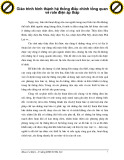
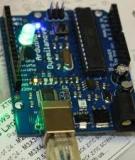

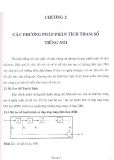
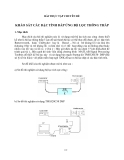
![Đề cương thực tập công nhân điện - điện tử [mới nhất]](https://cdn.tailieu.vn/images/document/thumbnail/2011/20111219/bonsai89/135x160/de_cuong_thuc_tap_cong_nhan_dien_dientu_8507.jpg)
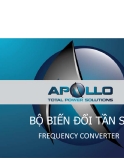
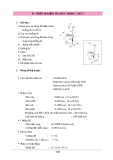
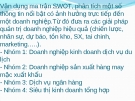

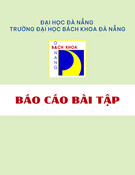





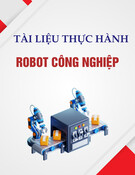




![Bài giảng Kỹ thuật robot [Mới nhất]](https://cdn.tailieu.vn/images/document/thumbnail/2025/20250715/vijiraiya/135x160/366_bai-giang-ky-thuat-robot.jpg)
![Câu hỏi ôn tập Cơ sở xử lý ảnh số [năm] chuẩn nhất](https://cdn.tailieu.vn/images/document/thumbnail/2025/20250710/kimphuong1001/135x160/84701752136985.jpg)

![Câu hỏi ôn tập Robot công nghiệp [năm hiện tại]](https://cdn.tailieu.vn/images/document/thumbnail/2025/20250702/kimphuong555/135x160/7711751422232.jpg)
